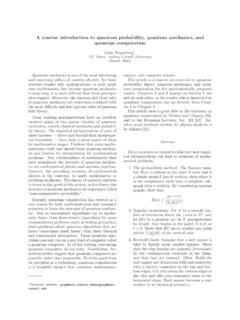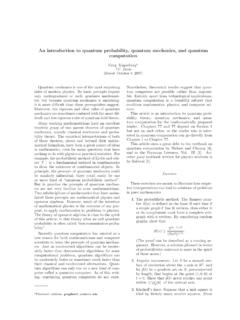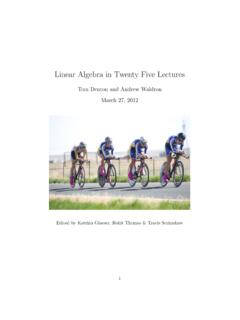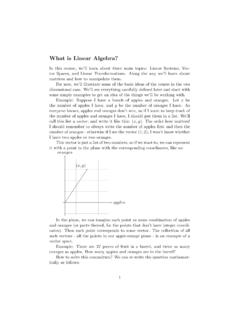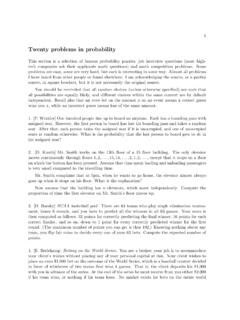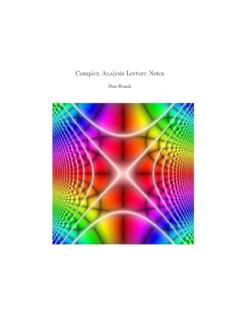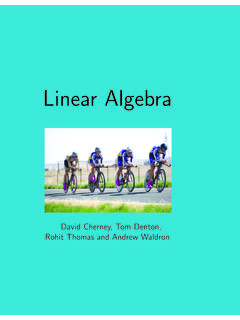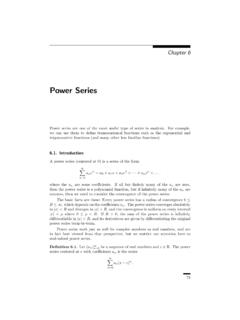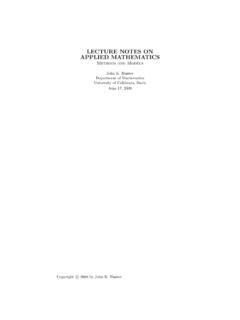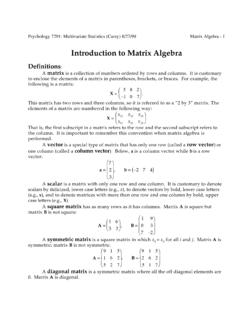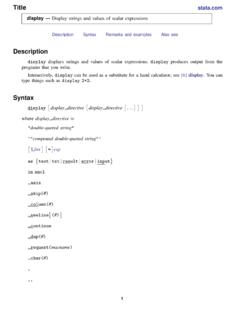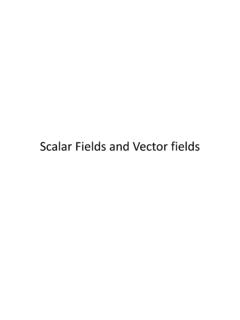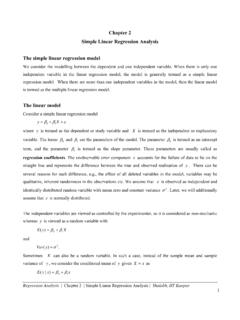Transcription of Chapter 3
1 Chapter3 Continuous FunctionsIn this Chapter , we define continuous functions and study their ContinuityAccording to the definition introduced by Cauchy, and developed by Weierstrass,continuous functions are functions that take nearby values at nearby nition :A R, whereA R, and suppose thatc A. Thenfiscontinuous atcif for every >0 there exists a >0 such that|x c|< andx Aimplies that|f(x) f(c)|< .A functionf:A Ris continuous on a setB Aif it is continuous at everypoint inB, and continuous if it is continuous at every point of its definition of continuity at a point may be stated in terms of neighborhoodsas nition functionf:A R, whereA R, is continuous atc Aif forevery neighborhoodVoff(c) there is a neighborhoodUofcsuch thatx A Uimplies thatf(x) V .The - definition corresponds to the case whenVis an -neighborhood off(c)andUis a -neighborhood ofc. We leave it as an exercise to prove that thesedefinitions are thatcmust belong to the domainAoffin order to define the continuityoffatc.
2 Ifcis an isolated point ofA, then the continuity condition holds auto-matically since, for sufficiently small >0, the only pointx Awith|x c|< isx=c, and then 0 =|f(x) f(c)|< . Thus, a function is continuous at everyisolated point of its domain, and isolated points are not of much Continuous FunctionsIfc Ais an accumulation point ofA, then continuity offatcis equivalentto the condition thatlimx!cf(x) =f(c),meaning that the limit offasx cexists and is equal to the value : (a, b) Ris defined on an open interval, thenfis continuouson (a, b) if and only iflimx!cf(x) =f(c) for everya < c < bsince every point of (a, b) is an accumulation : [a, b] Ris defined on a closed, bounded interval, thenfiscontinuous on [a, b] if and only iflimx!cf(x) =f(c)for everya < c < b,limx!a+f(x) =f(a),limx!b f(x) =f(b).Example thatA={0,1,12,13, .. ,1n, ..}andf:A Ris defined byf(0) =y0,f(1n)=ynfor some valuesy0, yn R. Then 1/nis an isolated point ofAfor everyn N,sofis continuous at 1/nfor every choice ofyn.
3 The remaining point 0 Ais anaccumulation point ofA, and the condition forfto be continuous at 0 is thatlimn!1yn= for limits, we can give an equivalent sequential definition of continuity, whichfollows immediately from :A Randc Ais an accumulation point ofA, thenfiscontinuous atcif and only iflimn!1f(xn) =f(c)for every sequence (xn) inAsuch thatxn casn .In particular,fis discontinuous atc Aif there is sequence (xn) in the domainAoffsuch thatxn cbutf(xn) f(c).Let s consider some examples of continuous and discontinuous functions toillustrate the functionf: [0, ) Rdefined byf(x) = xis continuouson [0, ). To prove thatfis continuous atc >0, we note that for 0 x < ,|f(x) f(c)|= x c = x c x+ c 1 c|x c|, Continuity23so given >0, we can choose = c >0 in the definition of continuity. To provethatfis continuous at 0, we note that if 0 x < where = 2>0, then|f(x) f(0)|= x < .Example function sin :R Ris continuous onR. To prove this, we usethe trigonometric identity for the difference of sines and the inequality|sinx| |x|:|sinx sinc|= 2 cos(x+c2)sin(x c2) 2 sin(x c2) |x c|.]]
4 It follows that we can take = in the definition of continuity for everyc sign function sgn :R R, defined bysgnx= 1 ifx >0,0 ifx= 0, 1 ifx <0,is not continuous at 0 since limx!0sgnxdoes not exist (see ). The leftand right limits of sgn at 0,limx!0 f(x) = 1,limx!0+f(x) = 1,do exist, but they are unequal. We say thatfhas a jump discontinuity at functionf:R Rdefined byf(x) ={1/xifx = 0,0ifx= 0,is not continuous at 0 since limx!0f(x) does not exist (see ). Neitherthe left or right limits offat 0 exist either, and we say thatfhas an essentialdiscontinuity at functionf:R R, defined byf(x) ={sin(1/x) ifx = 0,0ifx= continuous atc = 0 (see ) but discontinuous at 0 becauselimx!0f(x) does not exist (see ).Example functionf:R Rdefined byf(x) ={xsin(1/x) ifx = 0,0ifx= continuous at every point ofR. (See Figure1. The continuity atc = 0 is provedin To prove continuity at 0, note that forx = 0,|f(x) f(0)|=|xsin(1/x)| |x|,243. Continuous Functions 3 2 10123 plot of the functiony=xsin(1=x) and a detail near the originwith the linesy= xshown in (x) f(0) asx 0.)}}}
5 If we had definedf(0) to be any value other than0, thenfwould not be continuous at 0. In that case,fwould have a removablediscontinuity at Dirichlet functionf:R Rdefined byf(x) ={1 ifx Q,0 ifx / Qis discontinuous at everyc R. Ifc / Q, choose a sequence (xn) of rationalnumbers such thatxn c(possible sinceQis dense inR). Thenxn candf(xn) 1 butf(c) = 0. Ifc Q, choose a sequence (xn) of irrational numberssuch thatxn c; for example ifc=p/q, we can takexn=pq+ 2n,sincexn Qwould imply that 2 Q. Thenxn candf(xn) 0 butf(c) = 1. In fact, taking a rational sequence (xn) and an irrational sequence ( xn)that converge toc, we see that limx!cf(x) does not exist for anyc Thomae functionf:R Rdefined byf(x) ={1/qifx=p/qwherepandq >0 are relatively prime,0 ifx / Qorx= 0is continuous at 0 and every irrational number and discontinuous at every nonzerorational number. See Figure2for a can give a rough classification of a discontinuity of a functionf:A Ratan accumulation pointc Aas follows.}}
6 (1)Removable discontinuity: limx!cf(x) =Lexists butL =f(c), in which casewe can makefcontinuous atcby redefiningf(c) =L(see ).(2)Jump discontinuity: limx!cf(x) doesn t exist, but both the left and rightlimits limx!c f(x), limx!c+f(x) exist and are different (see ). Properties of continuous functions25 Figure plot of the Thomae function on [0;1](3)Essential discontinuity: limx!cf(x) doesn t exist and at least one of the leftor right limits limx!c f(x), limx!c+f(x) doesn t exist (see , , ). Properties of continuous functionsThe basic properties of continuous functions follow from those of , g:A Rare continuous atc Aandk R, thenkf,f+g,andf gare continuous atc. Moreover, ifg(c) = 0 thenf /gis continuous result follows immediately A polynomial function is a functionP:R Rof the formP(x) =a0+a1x+a2x2+ +anxnwherea0, a1, a2, .. , anare real coefficients. A rational functionRis a ratio ofpolynomialsP,QR(x) =P(x)Q(x).The domain ofRis the set of points inRsuch thatQ = polynomial function is continuous onRand every rationalfunction is continuous on its constant functionf(x) = 1 and the identity functiong(x) =xarecontinuous onR.
7 Repeated application of scalar multiples, sums,and products implies that every polynomial is continuous onR. It also follows thata rational functionR=P/Qis continuous at every point whereQ = 0. 263. Continuous FunctionsExample functionf:R Rgiven byf(x) =x+ 3x3+ 5x51 +x2+x4is continuous onRsince it is a rational function whose denominator never addition to forming sums, products and quotients, another way to build upmore complicated functions from simpler functions is by recall that iff:A Randg:B Rwheref(A) B, meaning that thedomain ofgcontains the range off, then we define the compositiong f:A Rby(g f)(x) =g(f(x)).The next theorem states that the composition of continuous functions is carefully the points at which we assumefandgare :A Randg:B Rwheref(A) B. Iffis continuousatc Aandgis continuous atf(c) B, theng f:A Ris continuous >0 be given. Sincegis continuous atf(c), there exists >0 suchthat|y f(c)|< andy Bimplies that|g(y) g(f(c))|<.
8 Next, sincefis continuous atc, there exists >0 such that|x c|< andx Aimplies that|f(x) f(c)|< .Combing these inequalities, we get that|x c|< andx Aimplies that|g(f(x)) g(f(c))|< ,which proves thatg fis continuous atc. Corollary :A Randg:B Rwheref(A) B. Iffis continuousonAandgis continuous onf(A), theng fis continuous functionf(x) ={sin(1/x) ifx = 0,0ifx= continuous onR\{0}, since it is the composition ofx7 1/x, which is continuousonR\{0}, andy7 siny, which is continuous functionf(x) ={xsin(1/x) ifx = 0,0ifx= continuous onR\{0}since it is a product of functions that are continuous onR\{0}. As shown in ,fis also continuous at 0, sofis Uniform Uniform continuityUniform continuity is a subtle but powerful strengthening of nition :A R, whereA R. Thenfis uniformly continuousonAif for every >0 there exists a >0 such that|x y|< andx, y Aimplies that|f(x) f(y)|< .The key point of this definition is that depends only on , not onx,y. Auniformly continuous function onAis continuous at every point ofA, but theconverse is not true, as we explain a function is continuous onA, then given >0 there exists (c)>0 for everyc Asuch that|x c|< (c) andx Aimplies that|f(x) f(c)|<.}}
9 In general, (c) depends on both andc, but we don t show the -dependenceexplicitly since we re thinking of as fixed. Ifinfc2A (c) = 0however we choose (c), then no 0>0 depending only on works simultaneouslyfor allc A. In that case, the function is continuous onAbut not giving examples, we state a sequential condition for uniform continuityto functionf:A Ris not uniformly continuous onAif andonly if there exists 0>0 and sequences (xn), (yn) inAsuch thatlimn!1|xn yn|= 0 and|f(xn) f(yn)| 0for alln not uniformly continuous, then there exists 0>0 such that for every >0 there are pointsx, y Awith|x y|< and|f(x) f(y)| 0. Choosingxn, yn Ato be any such points for = 1/n, we get the required , if the sequential condition holds, then for every >0 there existsn Nsuch that|xn yn|< and|f(xn) f(yn)| 0. It follows that the uniformcontinuity condition in hold for any >0 if = 0, sofisnot uniformly continuous. Example that the sine function is uniformly continuousonR, since we can take = for everyx, y : [0,1] Rbyf(x) =x2.
10 Thenfis uniformly continuouson [0,1]. To prove this, note that for allx, y [0,1] we have x2 y2 =|x+y||x y| 2|x y|,so we can take = /2 in the definition of uniform continuity. Similarly,f(x) =x2is uniformly continuous on any bounded Continuous FunctionsExample functionf(x) =x2is continuous but not uniformly continuousonR. We have already proved thatfis continuous onR(it s a polynomial). Toprove thatfis not uniformly continuous, letxn=n,yn=n+ !1|xn yn|= limn!11n= 0,but|f(xn) f(yn)|=(n+1n)2 n2= 2 +1n2 2 for everyn follows from not uniformly continuous onR. Theproblem here is that, for given >0, we need to make (c) smaller ascgets largerto prove the continuity offatc, and (c) 0 asc .Example functionf: (0,1] Rdefined byf(x) =1xis continuous but not uniformly continuous on (0,1]. We have already proved thatfis continuous on (0,1] (it s a rational function whose denominatorxis nonzero in(0,1]). To prove thatfis not uniformly continuous, definexn, yn (0,1] forn Nbyxn=1n,yn=1n+ 0,yn 0, and|xn yn| 0 asn , but|f(xn) f(yn)|= (n+ 1) n= 1 for everyn follows from not uniformly continuous on (0,1].))))))

